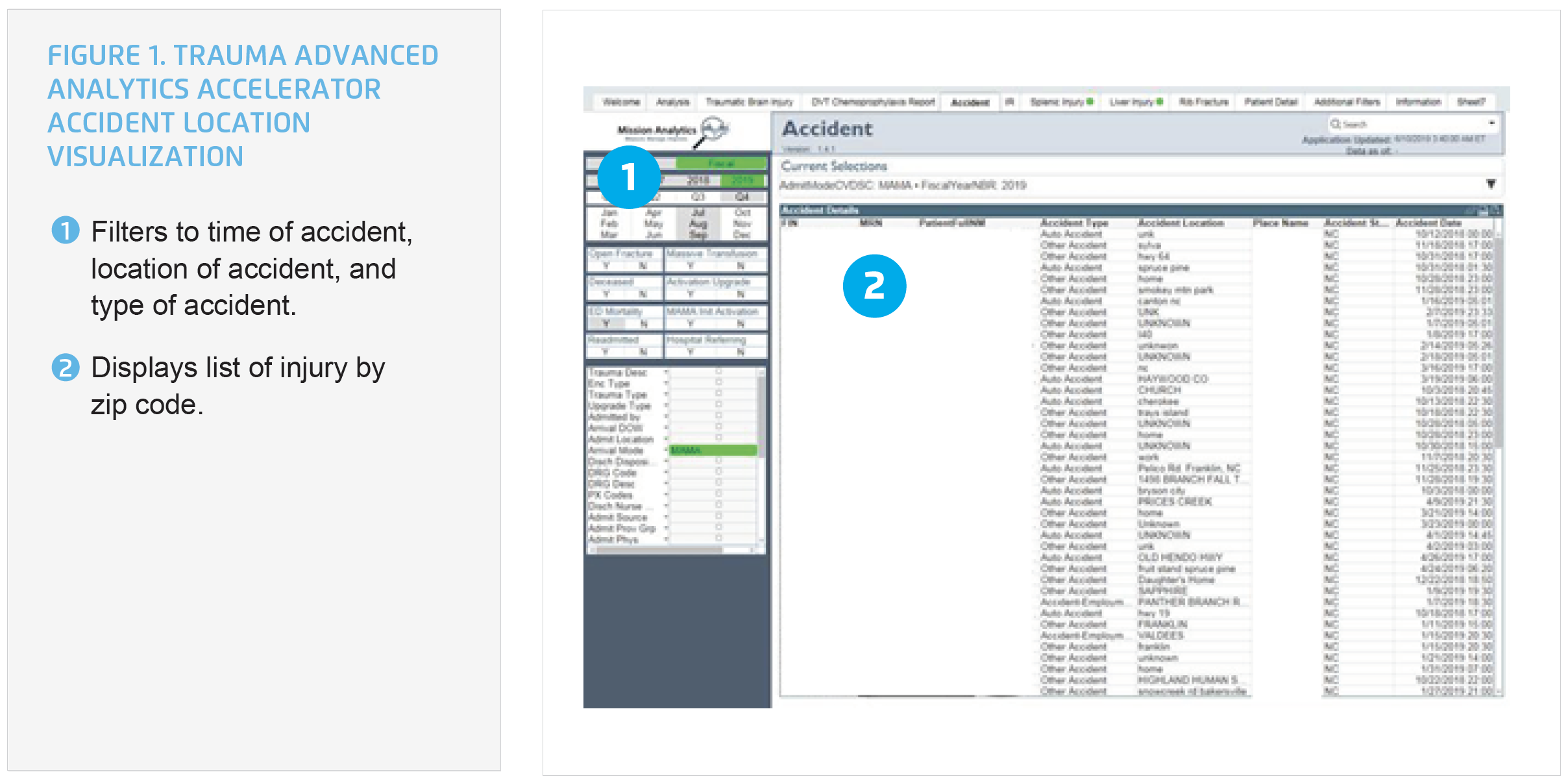Actionable Analytics Enables Improved Care, Reduced LOS, and Costs in Patients with Traumatic Brain Injury

- 11.3 percent relative decrease in the geometric length of stay (LOS) for patients with TBI, resulting in $441K in cost avoidance.
- $371K in savings, the result of an 18 percent relative reduction in the cost per case for patients with TBI.
To provide high-quality, cost-effective care to patients with traumatic brain injury (TBI), Mission Health needed insight into individual patient and provider performance data. Without access to accurate data, Mission couldn’t accurately pinpoint patient outliers, understand causes of TBI, and identify opportunities to improve TBI patient care. By utilizing its data platform and analytics accelerators, Mission was able to utilize patient data to identify patients suffering from TBI.
MISSION HEALTH STRIVES TO IMPROVE TRAUMATIC BRAIN INJURY CARE
TBI ranges in severity from a mild concussion to severe brain injury, resulting in permanent brain damage that can require hospitalization, rehabilitation therapies, or even lead to death. In the U.S., TBI accounts for over 280,000 hospitalizations annually.1,2
One of the nation’s leading providers of healthcare services, HCA Healthcare is made up of locally managed facilities that include 185 hospitals and 119 freestanding surgery centers located in 21 U.S. states and in the United Kingdom. Mission Health, an operating division of HCA, based in Asheville, North Carolina, is the state’s sixth-largest health system and includes six hospitals, numerous outpatient and surgery centers, post-acute care provider CarePartners, and the long-term acute care provider Asheville Specialty Hospital. It also has the region’s only dedicated Level II trauma center, Mission Hospital, which provides care to over 3,500 trauma registry patients annually.
LACK OF TIMELY DATA AND PROTOCOL CREATES ROADBLOCKS TO DELIVERING QUALITY CARE
The Mission trauma program has access to large volumes of data, with over 500 data points entered into the trauma registry for every patient. The overwhelming volume of data limited the ability to prospectively review data. Mission relied on retrospective reviews of care processes, impeding its ability to identify improvement efforts in a timely manner.
Trauma team clinicians provide evidence-based care; however, Mission lacked standard TBI care protocols. Benchmark data obtained from the Trauma Quality Improvement Program (TQIP) database was delayed by as much as 12 months, postponing the ability to identify care variation and limiting the timely development of performance improvement efforts once variation was identified.
Mission lacked insight into individual patient and provider performance data, making it difficult to identify patient outliers, understand reasons for outliers, and identify opportunities to improve TBI care. The health system needed an actionable analytics solution to gain insight into TBI care, allowing it to more effectively guide improvement efforts, decrease care variation, and improve patient outcomes.
ACTIONABLE, TIMELY ANALYTICS LEADS TO IMPROVED PATIENT OUTCOMES
As a data-driven organization, Mission leveraged the Health Catalyst® Data Operating System (DOS™) and a robust suite of analytics applications, including the Trauma Advanced Analytics Accelerator, to gain insight into trauma injury data.
The analytics accelerator allows the multidisciplinary team to sift through the large volumes of trauma data, enabling rapid identification of trends in care delivery and outcomes of trauma patients. Mission is able to efficiently review patterns of injury, injury-specific LOS, 30-day readmission rates, and costs of care. The health system can also compare the impact of interventions on specific populations of patients.
Using the analytics accelerator and robust trauma program data, Mission identified an opportunity to improve the care provided to its patients with TBI. The organization uses care process models (CPMs) to standardize care and ensure that the care provided throughout the organization—regardless of the patient’s location—is evidence-based best practice, patient-centered, and delivered in the right care setting at the lowest cost to patients.
The Mission trauma program team members, in collaboration with key stakeholders, developed a CPM for the care of patients with TBI. The CPM delineates standard evidence-based protocols, including order sets used to treat patients with TBI. The CPM includes the expected care from the point of presentation to discharge, including the care for patients admitted for inpatient care. Mission provided education to clinicians on the CPM, using peer-to-peer conversations and education/updates at ongoing department meetings.
The trauma program team uses the analytics accelerator to proactively identify the number of patients with TBI and the number of patients who received standard CPM care interventions. Access to actionable data enables the team to evaluate the effectiveness of evidence-based protocols for specific injuries and the impact those protocols have on patient outcomes. When unwarranted care variation exists, the trauma program team can follow the cases more closely to determine the reasons for the outliers and follow up with clinicians for loop closure.
Mission’s trauma program team members review data in near real-time, monitoring processes and providing feedback to clinicians about individual performance. Each provider involved in the care of patients with TBI has access to the analytics accelerator, allowing them to review their individual use of the CPM and their individual TBI outcome performance.
Injury prevention is an essential component of the trauma program. To identify ways to prevent injury, the trauma program team uses the analytics accelerator to identify specific locations in which TBIs occurred, analyzing the data for geographic trends (see Figure 1).

The trauma program is able to use the geographic data to plan and provide TBI injury prevention education to the communities with higher numbers of TBIs, potentially decreasing the number of TBIs occurring within the community.
RESULTS
Access to actionable data allowed the trauma program team to monitor CPM compliance and provide individualized feedback. Increased use of the CPM has led to decreased unwarranted clinical variation, resulting in a reduction in LOS and cost of care for patients with TBIs without negatively impacting mortality rates:
- 11.3 percent relative decrease in the geometric LOS for patients with TBI, decreasing costs by $441,322.
- 18 percent relative reduction in the cost per case for patients with TBI, decreasing costs by $371,184.
“Having actionable analytics rather than relying on literature is a giant leap, enabling review of the TBI population process data in near real-time. We are able to look at the care from the time of admission throughout the hospitalization, enabling linkage of care plans and alerts to improve patient outcomes.”
– William Shillinglaw, DO, Medical Director Trauma/Critical Care Services, Mission Hospitals
WHAT’S NEXT
Using this approach, Mission intends to further develop the TBI CPM to include abbreviated injury scale scoring to drive the timing of venous thromboembolic prophylaxis to facilitate neurologic recovery and reduced progression of brain injury.
REFERENCES
- Statista. (2019). Concussion and traumatic brain injury in the U.S.- Statistics & Facts.
- Centers for Disease Control and Prevention. (2019). TBI-related hospitalizations.
This website stores data such as cookies to enable essential site functionality, as well as marketing, personalization, and analytics. By remaining on this website you indicate your consent. For more information please visit our Privacy Policy.